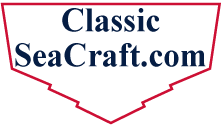Quote:
Originally Posted by Pinnhead13

. . . I plan on doing (for the first time) stringers, transom, deck and whatever else may need attending to.
I am open to any and all criticism and you guys know what's best for these boats . . .
|
Welcome aboard! As FS says, you have a Moesly hull, which is probably even better than the Potter models, since Potter learned whatever he knew about building boats from Moesly! That round plate on the transom indicates that it has (or had at one time) the original Moesly-designed live well under the stbd. transom seat. It was a clever circulating design that would keep bait alive without needing a pump, but it could be a transom killer if the sealing around that plate wasn't maintained. Check out Carla's
Moesly SeaCraft web site to learn more about the
amazing guy who founded SeaCraft, invented the patented VDH design, and became a legendary winner of offshore powerboat races with it!
The stringers in the '72 and earlier 4-stringer hulls are all glass with no foam in them, so should not need
any work unless you try to remove the deck. The keelson is a glass encapsulated wood 2x4, but has enough glass around it that it's got plenty of strength even if the wood is completely rotted. The deck/inner liner was bonded to the top of the stringers, so if you try to remove it, you may rip off the top of the stingers. If there are any soft spots, it's better to just remove the top skin and rotted core and leave the bottom skin intact.
When you start looking at power options, remember that the 20' hulls are very stiff but relatively light with less beam than most modern 20' boats (which is why these older hulls ride so well!), so they're fairly weight sensitive. The outboard models were designed for motors weighing 300 lbs or less, and the VDH design is very efficient, so unlike fatter heavier modern boats, they don't need a lot of power, and they are NOT good candidates for modern 500 lb 4-stroke motors! You'll get the best ride and minimum planing speed with smaller lighter motors of 90 to about 130 HP. Although I am now running a 430 lb V-6 on a bracket, I ran the same boat for over 30 years with a 300 lb ~100 hp (at the prop) motor on the transom, my experience was that I had to do a lot of tweaking to the current setup to get it to ride as well as it did with the old motor! It's hard to find a modern 300 lb motor however, so consider moving the console, batteries and fuel tank forward to help balance what will probably be a heavier-than-design motor! Moesly always put the gas tank right on the CG so trim would not change as you burned off fuel, so I'd recommend trying to keep the CG in that location when you start moving gear around to compensate for a heavier motor.

